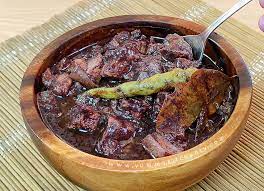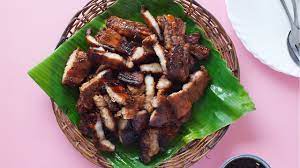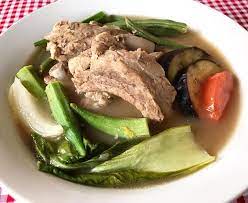

Filipino cuisine is known for its diverse flavors and unique cooking techniques, and pork is a staple ingredient in many Filipino dishes. From the popular lechon to the lesser-known adobo sa gata, there are countless ways to explore the amazing world of Filipino pork recipe. With so many delicious options to choose from, it can be overwhelming to decide which ones to try first.
From crispy delights to comforting stews, the Philippines has an impressive repertoire of pork dishes that will leave you craving for more. In this tantalizing compilation, we’ve handpicked the 39 best Filipino pork recipes you simply must try this year. Get ready to embark on a journey that will transport you to the bustling streets of Manila, the aromatic markets of Cebu, and the cozy kitchens of countless Filipino households.
Filipino cuisine, with its unique blend of indigenous, Spanish, Chinese, and American influences, offers a melting pot of flavors that is simply irresistible. While the pork adobo might be the most well-known dish from the Philippines, there is so much more to discover and savor. We’ve curated a diverse selection of recipes that showcase the creativity and culinary prowess of Filipino cooks.
Whether you’re a seasoned foodie or new to Filipino cuisine, this compilation of the 39 best Filipino pork recipes is sure to ignite your taste buds and inspire you to try something new in the kitchen. Join us as we celebrate the vibrant flavors, rich history, and cultural heritage of the Philippines through its most beloved ingredient: pork.
So grab your apron, sharpen your knives, and let’s dive into the world of Filipino pork dishes together. Get ready to create unforgettable culinary experiences that will transport you to the tropical paradise of the Philippines, one delicious bite at a time.
1. Pork Adobo

A beloved staple of Filipino cuisine, pork adobo is a delectable dish that combines the tanginess of vinegar, the richness of soy sauce, and the aromatic flavors of garlic and spices.
To prepare this dish, tender chunks of pork are marinated in a mixture of vinegar, soy sauce, minced garlic, bay leaves, and black peppercorns. The marinated pork is then slowly simmered until it becomes tender and infused with the rich flavors of the marinade.
Pork adobo is best enjoyed when served with steaming white rice, allowing you to savor the contrasting flavors and textures. The tender pork, soaked in the tangy and savory sauce, pairs perfectly with the fluffy rice. The combination of the acidic vinegar and soy sauce creates a harmonious balance of flavors that is both comforting and appetizing.
Apart from its delightful taste, pork adobo also offers several health benefits. The vinegar used in the marinade contains acetic acid, which has been associated with various health benefits. It may help lower blood sugar levels, improve insulin sensitivity, and aid digestion.
The garlic used in adobo is known for its antioxidant properties, which can help boost the immune system and protect against oxidative stress. Also, the slow cooking process of adobo helps to tenderize the pork, making it easier to digest and absorb its nutrients.
2. Lechon Kawali

If you’re looking for a dish that combines crispy indulgence with succulent flavors, lechon kawali is the perfect choice. This Filipino delight features tender and juicy pork belly with a mouthwatering, crackling-crisp skin. To achieve the perfect texture, the pork belly is first boiled until it becomes tender, and then deep-fried until the skin turns irresistibly crispy and golden brown.
Lechon kawali is often served as a centerpiece at festive occasions and gatherings. It’s commonly enjoyed with a side of lechon sauce, a sweet and tangy condiment made from liver, vinegar, sugar, and spices. The contrast between the crispy skin and the melt-in-your-mouth pork meat is a delight for the senses.
While lechon kawali may not be the healthiest option due to its high-fat content, it can still provide some nutritional benefits. Pork belly is a good source of protein and essential amino acids, which are important for muscle growth, repair, and overall body function. It also contains B vitamins, iron, and zinc, which are essential for energy production, cognitive function, and a healthy immune system.
Indulging in lechon kawali occasionally as part of a balanced diet can be a flavorful and enjoyable experience. Remember to practice portion control and balance it with plenty of vegetables and whole grains to maintain a well-rounded meal.
3. Pork Binagoongan

Pork Binagoongan is one of the best Filipino pork recipes that you must try this year. This dish is a combination of savory and sweet flavors, making it an appetizing meal for everyone. It’s a classic Filipino dish that has been passed down from generations to generations, and it’s still as popular today as it was in the past.
The main ingredient of this recipe is pork belly, which is cooked with shrimp paste or bagoong alamang. The shrimp paste gives the dish a unique taste that you won’t find anywhere else. The combination of salty and sweet flavors creates a delicious balance in every bite.
Aside from being tasty, Pork Binagoongan is also easy to prepare, which makes it perfect for busy individuals who don’t have much time to cook.
4. Pork Caldereta

Pork Caldereta is a comforting and robust stew that is loved by many Filipinos. This dish features tender pork chunks simmered in a rich tomato-based sauce, along with bell peppers, carrots, potatoes, and green peas.
The flavors are further enhanced by the addition of liver spread, which gives the sauce a velvety texture and a depth of flavor. Pork Caldereta is often enjoyed with steamed rice or crusty bread, allowing you to soak up the luscious sauce. This hearty stew not only satisfies the taste buds but also provides nutritional benefits.
Pork is a good source of protein, iron, and B vitamins, while the assortment of vegetables adds fiber, vitamins, and antioxidants. Treat yourself to a bowl of Pork Caldereta for a comforting and nourishing Filipino meal.
5. Pork Humba

Pork Humba is a sweet and savory pork dish that hails from the Visayas region of the Philippines. It features pork belly or pork hocks braised in a combination of soy sauce, vinegar, brown sugar, and various spices.
The slow braising process allows the flavors to meld together, resulting in tender and flavorful meat with a sticky glaze. Pork Humba is often enjoyed with steamed rice, allowing you to savor the balance of sweet and savory flavors. While this dish is on the sweeter side, the use of pork belly provides a rich source of protein and healthy fats. The soy sauce adds umami flavor and the vinegar provides a tangy kick.
Indulge in Pork Humba as a comforting and indulgent treat.
6. Pork Barbecue

Pork Barbecue is a popular street food in the Philippines, often enjoyed as a quick and flavorful snack. Thinly sliced pork pieces are marinated in a sweet and tangy sauce, typically made from soy sauce, ketchup, calamansi juice, garlic, and spices.
The marinated pork is then skewered and grilled to perfection, resulting in juicy and tender meat with a caramelized exterior. Pork Barbecue is best enjoyed fresh off the grill, with a side of vinegar dipping sauce and steamed rice. While this dish is on the indulgent side, pork provides protein and essential amino acids.
The marinade can be adjusted to include less sugar or healthier alternatives for a lighter version of this beloved Filipino street food.
7. Pork Binagoongang Baboy

Pork Binagoongang Baboy is a flavorful and aromatic dish that showcases the distinctive taste of shrimp paste, or bagoong. Cubed pork is sautéed with garlic, onions, tomatoes, and shrimp paste, creating a savory and slightly salty flavor profile.
The addition of coconut milk adds creaminess and balances the flavors. Pork Binagoongang Baboy is best enjoyed with steamed rice, allowing you to savor the complex flavors. While shrimp paste is high in sodium, pork provides protein, essential amino acids, and various vitamins and minerals. The use of fresh tomatoes adds a dose of vitamin C and antioxidants.
Enjoy this unique and flavorful dish in moderation for a taste of authentic Filipino cuisine.
8. Pork Longganisa

Pork Longganisa is a Filipino-style sausage that is loved for its sweet and savory flavors. Ground pork is mixed with garlic, sugar, soy sauce, vinegar, and various spices, then formed into sausage links.
Pork Longganisa is often pan-fried until golden brown and served with garlic fried rice and a side of vinegar for dipping. The combination of sweet and savory flavors creates a delightful harmony that is perfect for breakfast or brunch. While this dish is on the indulgent side, pork provides protein and essential amino acids.
The use of garlic adds a boost of flavor and potential health benefits, including immune support and heart health. Treat yourself to the delightful flavors of Pork Longganisa for a satisfying meal.
9. Pork Sinigang sa Sampalok

Pork Sinigang sa Sampalok is a classic Filipino soup known for its sour and tangy taste. This comforting dish features tender pork ribs or pork belly simmered in a broth made from tamarind pulp, tomatoes, and various vegetables such as kangkong (water spinach), radish, and eggplant.
The sourness of the tamarind adds a refreshing element to the dish, while the pork lends richness and depth of flavor. Pork Sinigang sa Sampalok is best enjoyed with steamed rice, allowing you to soak up the flavorful broth.
Tamarind is known to be rich in vitamin C and antioxidants, which can boost immunity and fight inflammation. The combination of vegetables adds fiber, vitamins, and minerals to the dish, making it a nutritious and delicious choice for a comforting meal.
10. Pork Tinola

Pork Tinola is a light and comforting Filipino soup that warms both your body and soul. This traditional dish is made with tender pieces of pork, fragrant ginger, garlic, onion, and either green papaya or chayote. The combination of these simple yet flavorful ingredients creates a nourishing and aromatic soup that is perfect for enjoying on colder days or when you’re feeling under the weather.
The star of Pork Tinola is the tender pork, which adds a rich and meaty flavor to the broth. The ginger brings a warming and invigorating element, as well as its potential immune-boosting and digestive benefits. The garlic and onion contribute their distinct aromas and flavors, enhancing the overall taste profile of the soup.
The addition of green papaya or chayote adds a refreshing and slightly sweet note to the dish. These vegetables are not only delicious but also provide essential vitamins, minerals, and dietary fiber. They contribute to the overall nutritional value of the soup, promoting good digestion and supporting overall well-being.
11. Pork Kare-Kare

Pork Kare-Kare is a hearty and flavorful stew that is a favorite among Filipino households. It features tender chunks of pork simmered in a rich peanut sauce, along with a medley of vegetables such as eggplant, bok choy, and string beans.
The sauce is thick and creamy, with a nutty flavor that is both comforting and indulgent. Pork Kare-Kare is traditionally enjoyed with bagoong, a fermented shrimp paste, which adds a salty and umami kick to the dish. The combination of tender pork, creamy peanut sauce, and the assortment of vegetables creates a harmonious balance of flavors and textures.
While this dish is on the indulgent side, pork provides protein, iron, and B vitamins, while the peanut sauce adds healthy fats, vitamins, and minerals. Treat yourself to a bowl of Pork Kare-Kare for a satisfying and flavorful meal.
12. Pork Afritada

Pork Afritada is not only a delicious and comforting dish but also offers several health benefits. This classic Filipino stew is packed with tender pork, vibrant vegetables, and flavors that not only satisfy your taste buds but also provide nourishment for your body. The pork used in Pork Afritada is a great source of protein, which is essential for building and repairing tissues, supporting muscle growth, and maintaining a healthy immune system.
The assortment of vegetables, including onions, garlic, bell peppers, carrots, and potatoes, adds not only color and texture but also a range of vitamins and minerals. Onions and garlic, for example, are known for their anti-inflammatory properties and potential immune-boosting benefits. Bell peppers are rich in vitamin C, an antioxidant that helps protect the body against oxidative stress and promotes collagen production for healthy skin.
Carrots provide beta-carotene, a precursor to vitamin A, which is crucial for good vision and immune function. Potatoes offer potassium, vitamin B6, and dietary fiber, contributing to heart health and digestion.
The tomato sauce used in Pork Afritada brings more than just a tangy and savory taste. Tomatoes are rich in lycopene, a powerful antioxidant known for its potential to reduce the risk of certain cancers and support heart health. They also contain vitamins A and C, as well as other beneficial compounds that promote overall well-being.
13. Pork Lechon

Pork Lechon is a Filipino delicacy that is known for its crispy skin and tender meat. This festive dish involves roasting a whole pig over an open fire, resulting in a succulent and flavorful centerpiece for celebrations and special occasions.
The pork is marinated with a blend of spices, herbs, and aromatics, giving it a distinct and mouthwatering flavor. The slow-roasting process creates a crispy skin that crackles with each bite, while the meat remains tender and juicy. Pork Lechon is often enjoyed with a side of liver sauce or vinegar for dipping, along with steamed rice and a variety of sides.
While Pork Lechon is undoubtedly indulgent and high in calories, it is usually reserved for special occasions. The crispy skin is a favorite among many, while the meat provides a rich source of protein. Indulge in Pork Lechon for a truly unforgettable culinary experience that showcases the artistry and flavors of Filipino cuisine.
14. Pork Sisig Tacos

Combine the flavors of Filipino sisig with the Mexican favorite, tacos, to create a delightful fusion dish that will take your taste buds on a flavor-packed journey. Sisig, a beloved Filipino dish, traditionally features pig’s face or cheeks that are boiled, grilled to perfection, and finely chopped. This process creates a deliciously crispy and savory meat base for the filling.
To prepare the sisig, the finely chopped pork is mixed with onions, chili peppers for a hint of spice, calamansi juice to add a tangy citrusy kick, and a touch of mayonnaise to enhance the creaminess. This combination of ingredients creates a harmonious balance of flavors that is both rich and satisfying.
When it comes to serving this fusion creation, warm tortillas are the perfect vessel to showcase the sisig. The soft and pliable tortillas provide the ideal base for the flavorful filling. Once the tortillas are heated, generously spoon the sisig onto each one. The crispy texture of the sisig pairs wonderfully with the freshness of the toppings.
To elevate the taste and presentation of your sisig tacos, garnish them with fresh cilantro, which adds a vibrant and herbaceous note. Diced tomatoes bring a juicy burst of sweetness and acidity, while a squeeze of lime adds a zesty tang that ties all the flavors together. The combination of the crispy and savory sisig with the refreshing toppings creates a unique and mouthwatering taco experience that will leave you craving more.
These sisig tacos not only offer a delightful fusion of Filipino and Mexican flavors but also provide a substantial meal. The pork used in sisig is a good source of protein, essential for muscle growth, repair, and overall body functions. The inclusion of onions, chili peppers, and calamansi juice adds beneficial antioxidants and vitamins to the dish.
Even the toppings contribute to the overall nutritional value, with cilantro providing essential vitamins and minerals, tomatoes offering vitamin C and antioxidants, and lime providing a boost of vitamin C as well.
15. Pork Estofado

Pork Estofado is a hearty and aromatic Filipino stew that is rich in flavors. This dish features pork simmered in a flavorful sauce made from soy sauce, vinegar, brown sugar, garlic, onions, and various spices. The addition of banana blossoms adds a unique and slightly sweet taste to the stew. Pork Estofado is best enjoyed with steamed rice, allowing you to soak up the luscious sauce.
The slow-cooking process allows the pork to become tender and infused with the delicious flavors of the sauce. The use of soy sauce and vinegar adds a tangy and savory element to the dish, while the banana blossoms provide texture and a touch of sweetness. Indulge in Pork Estofado for a comforting and satisfying meal.
The slow cooking process allows the flavors to melt together, resulting in a rich and savory dish. The pork used in Pork Estofado is a good source of protein, which is essential for muscle growth, repair, and overall body function.
The spices and herbs used in the dish, such as garlic and bay leaves, offer potential immune-boosting and anti-inflammatory properties. So, while indulging in the flavorsome Pork Estofado, you can also enjoy the health benefits it brings to the table.
16. Pork Dinuguan

Pork Dinuguan is a savory and hearty Filipino stew made from pork and pig’s blood. Although it may sound unusual, it is a beloved dish among Filipinos. The pork is simmered with vinegar, garlic, onions, and spices until tender, and then pig’s blood is added to create a thick and flavorful sauce.
The resulting stew is rich, tangy, and slightly spicy. Pork Dinuguan is often enjoyed with steamed rice or paired with puto (steamed rice cakes). Despite its unique main ingredient, pig’s blood, this dish is packed with flavor and nutritional benefits. Pork provides protein, while the use of vinegar adds a tangy kick and can aid digestion.
Step out of your comfort zone and give Pork Dinuguan a try for a taste of Filipino culinary tradition.
17. Pork Guisantes

Pork Guisantes is a delicious Filipino dish that showcases the flavors of pork and green peas. The dish features cubed pork simmered in a flavorful sauce made with tomatoes, onions, garlic, and spices, with the addition of sweet green peas. The combination of ingredients creates a savory and slightly sweet flavor profile.
Pork Guisantes is best enjoyed with steamed rice, allowing you to savor the delicious sauce. The tender pork, along with the green peas, provides a variety of vitamins, minerals, and fiber. Enjoy Pork Guisantes for a comforting and satisfying meal that highlights the simplicity and flavors of Filipino cuisine.
The pork used in Pork Guisantes is a good source of protein, essential for muscle growth, repair, and overall body function. The addition of green peas adds fiber, vitamins, and minerals to the dish. Green peas are known for their high content of vitamins K and C, as well as folate and dietary fiber, which promote heart health and aid in digestion.
Indulge in Pork Guisantes for a delicious and nourishing meal that not only delights your taste buds but also contributes to your overall well-being.
18. Pork Binagoongan Pizza

Take the flavors of the traditional Filipino Pork Binagoongan and transform them into a unique and delicious pizza. Start with a pizza dough base and spread a layer of tomato sauce. Top with chunks of pork binagoongan, sautéed onions and garlic, and a generous amount of shredded mozzarella cheese.
Bake until the crust is crispy and the cheese is melted and bubbly. The combination of the salty and savory pork binagoongan with the gooey cheese and aromatic onions creates a flavorful and satisfying pizza. Serve with a side of fresh greens or a spicy vinegar dip for a complete meal.
The pork used in this pizza provides a good amount of protein, necessary for building and repairing tissues, supporting muscle growth, and maintaining a healthy immune system. Also, the shrimp paste used in the dish adds a savory umami flavor and is a rich source of minerals like calcium and iron.
While indulging in Pork Binagoongan Pizza, you can enjoy the unique flavors while still benefiting from the nutritious aspects it offers.
19. Pork Menudo Spaghetti

Pork Menudo is another fantastic Filipino pork recipe. The process begins by preparing the flavorful Pork Menudo, where tender pieces of pork are slowly simmered in a luscious tomato-based sauce. This sauce is infused with a medley of vegetables such as potatoes, carrots, bell peppers, and peas, adding a delightful texture and an array of colors to the dish.
While the Pork Menudo simmers to perfection, cook your favorite spaghetti noodles according to the package instructions. The al dente pasta serves as the perfect base for this fusion creation. Once both the Pork Menudo and spaghetti noodles are ready, it’s time to bring them together.
To serve, generously ladle the aromatic Pork Menudo on top of the cooked spaghetti noodles. The succulent pieces of pork, along with the colorful vegetables, create a visually appealing and mouthwatering combination. To elevate the dish, sprinkle grated cheese over the top, allowing it to melt and add a creamy element to the fusion creation. A sprinkle of fresh chopped parsley adds a pop of freshness and serves as a delightful garnish.
The fusion of the savory Pork Menudo with the comforting and familiar taste of spaghetti creates a unique and satisfying meal that is bound to please both kids and adults alike.
The flavors of the tomato-based sauce, combined with the tender pork and vegetables, create a harmonious balance of taste and texture. The familiarity of spaghetti noodles brings a sense of comfort to the dish, making it a crowd-pleaser.
20. Pork Kare-Kare Burrito

This amazing and creative recipe puts a twist on the classic Filipino dish Kare-Kare by turning it into a flavorful and hearty burrito. Start by preparing the Pork Kare-Kare, featuring tender pork simmered in a rich peanut sauce with an array of vegetables such as eggplant, bok choy, and string beans.
Warm a tortilla and spoon a generous portion of the Pork Kare-Kare onto it. Add a scoop of steamed rice, a dollop of bagoong (fermented shrimp paste), and garnish with chopped cilantro and diced tomatoes. Wrap the burrito tightly and enjoy the fusion of flavors and textures.
The combination of the savory pork, creamy peanut sauce, and the richness of bagoong creates a unique and satisfying meal that will delight your taste buds an.
21. Pork Inihaw Salad

Create a refreshing and flavorful salad by incorporating the smoky flavors of Pork Inihaw. Start by grilling or broiling pork slices that have been marinated in a mixture of soy sauce, calamansi juice, garlic, and spices.
Once cooked, slice the pork into thin strips. In a large bowl, combine mixed greens, sliced tomatoes, cucumber, red onions, and grilled pork. Drizzle with a tangy vinaigrette made from calamansi juice, vinegar, olive oil, and a touch of honey.
Toss the salad to coat everything evenly. The combination of the smoky pork, fresh vegetables, and zesty vinaigrette creates a light and satisfying dish that is perfect for warm days or as a refreshing side dish.
22. Pork Pochero

Pork Pochero is a hearty and flavorful Filipino stew that brings together the succulent goodness of pork with a delightful assortment of vegetables and garbanzo beans. This classic dish features tender pieces of pork simmered in a rich and savory tomato-based broth, along with a colorful blend of cabbage, green beans, potatoes, and carrots.
The combination of flavors in Pork Pochero creates a comforting and filling stew that is perfect for family gatherings or cozy meals. The slow simmering process allows the pork to become tender and infused with the flavors of the broth, resulting in a satisfying and flavorful dish. The variety of vegetables not only adds vibrant colors to the stew but also contributes essential vitamins, minerals, and dietary fiber, making it a nourishing choice for a well-rounded meal.
When it comes to serving Pork Pochero, it is traditionally enjoyed with steamed rice. The steamed rice acts as a perfect accompaniment, allowing you to soak up the flavorful broth and savor every spoonful.
The combination of the tender pork, the medley of vegetables, and the aromatic broth creates a truly satisfying and nourishing meal that warms both your body and soul.
23. Pork Lumpia

Pork Lumpia is a popular Filipino appetizer that resembles spring rolls. It features a savory filling made with ground pork, onions, garlic, carrots, cabbage, and various seasonings.
The filling is wrapped in spring roll wrappers and deep-fried until golden and crispy. Pork Lumpia is often served with a sweet and sour dipping sauce or vinegar for dipping. The combination of the crispy exterior and the flavorful filling creates a satisfying and addictive snack. While deep-fried, this dish can be enjoyed in moderation.
The ground pork provides protein, while the vegetables add vitamins, minerals, and fiber. Serve Pork Lumpia as an appetizer or as part of a larger Filipino feast for a crowd-pleasing treat.
24. Pork Bicol Express

Pork Bicol Express is a fiery and flavorful dish that originates from the Bicol region of the Philippines, known for its love of spicy cuisine. This delectable dish showcases succulent pieces of pork cooked in a luscious coconut milk sauce infused with the bold flavors of shrimp paste, chili peppers, garlic, and ginger.
The combination of the creamy coconut milk and the fiery spices creates a tantalizing taste experience that is sure to excite your taste buds.
To fully enjoy Pork Bicol Express, it is traditionally served with steamed rice. The mildness of the rice provides a perfect balance to the spiciness of the dish, allowing you to savor the flavors without overwhelming your palate. The combination of the creamy coconut milk and the bold spices creates a harmonious fusion of flavors that will take you on a culinary journey to the vibrant and diverse cuisine of the Bicol region.
Not only does Pork Bicol Express offer a delightful taste experience, but it also provides several health benefits. Coconut milk, which forms the base of the sauce, is a rich source of healthy fats that can contribute to a well-balanced diet. These healthy fats provide energy, support brain function, and aid in the absorption of fat-soluble vitamins.
The pork in this dish adds protein, which is essential for muscle growth and repair, as well as the overall functioning of the body.
25. Pork Ribs Sinigang

Pork Ribs Sinigang is a hearty and tangy soup that is perfect for satisfying your cravings for both meat and sour flavors. This dish features pork ribs simmered in a tamarind-based broth with an assortment of vegetables such as kangkong (water spinach), radish, and okra. The sourness of the tamarind gives the soup a refreshing and tangy taste.
Pork Ribs Sinigang is best enjoyed with steamed rice, allowing you to soak up the flavorful broth. Tamarind is known for its high vitamin C content and antioxidants, which can support your immune system and fight inflammation. Delight in the robust flavors of Pork Ribs Sinigang for a comforting and nourishing meal.
Pork Ribs Sinigang offers several health benefits. The use of tamarind in the soup provides a good source of vitamin C and antioxidants, supporting immune health and fighting inflammation. The lean pork ribs contribute protein and essential nutrients, while the assortment of vegetables adds vitamins, minerals, and dietary fiber.
Enjoy Pork Ribs Sinigang as a nourishing and flavorful option for a well-rounded meal.
26. Pork Hamonado

Pork Hamonado is a sweet and savory Filipino dish that is perfect for special occasions and holiday feasts. It features pork marinated in a mixture of pineapple juice, soy sauce, brown sugar, and spices, then slow-cooked until tender and caramelized.
The combination of the sweet and tangy flavors of pineapple with the savory pork creates a delightful harmony. Pork Hamonado is typically served with steamed rice and garnished with pineapple slices and maraschino cherries for an extra touch of sweetness.
While this dish is on the indulgent side, it offers a balance of protein from the pork and the health benefits of pineapple, which is rich in vitamins and minerals. Treat yourself to the luscious flavors of Pork Hamonado for a truly festive dining experience.
27. Pork Giniling

Pork Giniling is a versatile and easy-to-make dish that is perfect for quick and satisfying meals. It features ground pork cooked with tomatoes, onions, garlic, and a medley of vegetables such as carrots and green peas.
The simplicity of this dish allows the flavors of the ingredients to shine through. Pork Giniling is often enjoyed with steamed rice, allowing you to savor the savory and comforting flavors.
The ground pork provides protein, while the addition of vegetables adds vitamins, minerals, and fiber to the dish. Whip up a batch of Pork Giniling for a delicious and fuss-free meal that will please the whole family.
28. Pork Caldereta

Pork Caldereta is a flavorful and hearty Filipino stew that is often reserved for special occasions and festive gatherings. This beloved dish features succulent pieces of pork that are slow-simmered in a luscious tomato-based sauce, enriched with the robust flavors of potatoes, carrots, bell peppers, and olives.
The combination of these carefully selected ingredients creates a rich and complex flavor profile that is both deeply savory and delicately tangy. The tender pork absorbs the vibrant flavors of the sauce, resulting in melt-in-your-mouth goodness that is truly satisfying.
The addition of potatoes, carrots, bell peppers, and olives adds layers of texture and a delightful medley of flavors to the dish, making each bite a delightful experience for your taste buds.
To fully appreciate the indulgent nature of Pork Caldereta, it is traditionally enjoyed with steamed rice. The fluffy rice serves as a perfect canvas for soaking up the luscious sauce, ensuring that you savor every last drop of the flavor-infused goodness.
The combination of the tender pork, the aromatic vegetables, and the rich sauce creates a harmonious blend that will satisfy your cravings and leave you wanting more.
29. Pork Tocino

Pork Tocino is a sweet and savory Filipino breakfast staple that will surely tantalize your taste buds. It features thinly sliced pork marinated in a mixture of sugar, soy sauce, pineapple juice, garlic, and various spices.
The marinated pork is then pan-fried until caramelized and tender. Pork Tocino is often enjoyed with garlic fried rice and a side of eggs. The combination of the sweet and salty flavors of the marinade creates a delightful contrast.
While this dish is on the sweeter side, it provides a good source of protein from the pork. Start your day with a delightful and flavorsome breakfast by indulging in Pork Tocino.
30. Pork Humba
Pork Humba is a succulent and tender dish that hails from the Visayan region of the Philippines. It is a braised pork dish that features chunks of pork belly cooked in a flavorful combination of soy sauce, vinegar, brown sugar, garlic, and various spices.
The slow cooking process allows the flavors to meld together, resulting in a rich and savory sauce that coats the pork. The pork belly becomes incredibly tender and melts in your mouth with each bite. The dish is often served with steamed rice, allowing you to soak up all the delicious sauce.
While indulging in Pork Humba, you can savor the health benefits of pork, which is a good source of protein and essential vitamins and minerals. Also, the garlic used in the dish offers potential immune-boosting and heart-healthy properties.
31. Pork Inasal

Pork Inasal, a beloved grilled dish that originated in the Visayas region of the Philippines, is a culinary delight that satisfies the cravings of meat lovers. This popular dish features marinated pork skewers that are grilled to perfection, resulting in juicy and flavorful meat with a delightful smoky taste.
The marinade used in Pork Inasal is the secret behind its mouthwatering flavor. A blend of vinegar, calamansi juice, garlic, ginger, lemongrass, and a medley of spices creates a tangy and aromatic mixture that infuses the pork with an irresistible taste. As the skewers sizzle on the grill, the marinade caramelizes, enhancing the natural flavors of the pork and adding a hint of charred goodness.
To complement the succulent pork, Pork Inasal is traditionally served with steamed rice, which acts as the perfect companion to soak up the flavors of the dish. A side of atchara, a pickled papaya relish, adds a refreshing and tangy element to the meal.
And for an extra burst of flavor, a dipping sauce made from vinegar and soy sauce is often provided, adding a savory kick to every bite.
32. Pork Sinigang Rice Bowl

Transforming the beloved flavors of the classic Filipino Sinigang into a delectable rice bowl creates a unique and convenient way to enjoy this iconic dish. The process begins with preparing the Pork Sinigang, where tender pork is simmered to perfection in a tangy tamarind broth.
The broth is infused with the flavors of an assortment of vegetables such as kangkong (water spinach), radish, and okra, creating a harmonious blend of textures and tastes.
To assemble the rice bowl, start by cooking your favorite rice until fluffy and fragrant. Once the rice is ready, transfer it to a bowl as the base. Then, generously spoon the flavorful Pork Sinigang on top of the rice, allowing the broth to seep into the grains, infusing them with its tangy essence. This marriage of the tangy broth and the fluffy rice creates a comforting and satisfying combination that will surely tantalize your taste buds.
To elevate the flavors further, garnish the rice bowl with fresh herbs such as cilantro or spring onions. These vibrant herbs provide a burst of freshness that balances the tangy notes of the Sinigang broth, adding a delightful element to each spoonful.
Frequently Asked Questions
One of the most famous pig foods in the Philippines is called “Lechon”. Lechon is a whole roasted pig that is seasoned with garlic, salt, and pepper. It is traditionally served during special occasions and holidays, such as Christmas and New Year’s. The meat is typically served with a variety of sauces, including vinegar-based sauces, garlic sauce, or even peanut sauce.
Another popular pig food in the Philippines is called “Tocino”. Tocino is a sweet cured pork dish that is usually served for breakfast. The pork is marinated in a mixture of sugar, pineapple juice, soy sauce, garlic, and other spices before it is cooked until it has a crispy texture. It can be served with eggs or rice for an extra flavorful meal.
Lastly, “Adobo Baboy” (pork adobo) is another popular Filipino dish made with pork.
Cooking the best pork meat starts with selecting the right cut. Depending on how you plan to cook it, different cuts of pork can work better than others. For example, if you’re grilling or pan-frying, a loin or tenderloin is ideal. If you’re slow-cooking, a shoulder roast is usually best.
Once you have your cut of pork, it’s important to season it properly. A simple rub of salt and pepper is always a great starting point. You can also add herbs and spices for more flavor. Let the pork sit for at least an hour before cooking to ensure that the seasoning has time to penetrate the meat.
Finally, make sure you cook your pork correctly according to the recipe or instructions you are using. The internal temperature should reach at least 145 degrees Fahrenheit in order for it to be safe to eat.
The pig, or swine, is known as baboy in the Philippines. This is derived from the Spanish word for pig, which is “cerdo”. Pigs are an important part of Filipino culture and cuisine. They are used to make a variety of dishes including lechon, which is a whole roasted pig.
In addition to being eaten as food, pigs are also kept by some Filipinos as pets and for agricultural purposes such as tilling soil. Pigs play an important role in Filipino culture and are often seen at festivals and other celebrations.
Filipino breakfast is typically a combination of savory and sweet dishes. A typical breakfast may include a fried egg, garlic rice, and a dish made from fish or pork.
Along with this, there can be some type of vegetable dish like sautéed okra or stir-fried squash. For something sweet, it’s common to have a fruit like mango or banana as well as a pastry such as pandesal (Filipino bread rolls) or ensaymada (Filipino brioche). Beverages like coffee, tea, and juice are also popular for breakfast in the Philippines.
In addition to these traditional breakfast items, many Filipinos enjoy eating classic American breakfasts such as pancakes, waffles, omelets, toast with jam or butter, and cereal. Other popular options include longganisa (Filipino sausage), tapa (cured beef), tocino (sweetened pork), and tuyo (dried fish).
Why do Filipinos love pork?
Pork has been a staple in Filipino cuisine for centuries. It is an affordable and versatile meat that can be cooked in many different ways, from the popular sisig dish to adobo and lechon.
Pork also has a lot of flavor, which makes it a favorite among Filipinos. In addition, pork is seen as a symbol of prosperity and celebration in the Philippines, often served during special occasions such as birthdays and holidays. For these reasons, pork is deeply embedded in Filipino culture and continues to be enjoyed by many generations.
How much is 1 pig in the Philippines?
The cost of a pig in the Philippines depends on several factors, such as its size and age. Generally speaking, a piglet can cost anywhere from 500 to 1000 Philippine pesos (PHP), while a full-grown pig can range from 2000 to 5000 PHP.
The price may also depend on where you purchase the pig – for example, buying directly from a local farmer may be cheaper than buying from a market or store. Ultimately, it’s best to shop around and compare prices before deciding on where to buy your pig.
Who brought pigs to the Philippines?
Pigs were first introduced to the Philippines by Spanish colonizers in the 16th century. The animals were brought over from Mexico and became an important part of Filipino culture.
Pigs are still a major source of food and income for many Filipino families today, and they are also used in traditional ceremonies and religious festivals. In addition, pigs have become a symbol of wealth and status in the Philippines, with some breeds being more expensive than others.
What do Filipinos eat during dinner?
Filipinos typically enjoy a wide variety of dishes for dinner. Depending on the region, there may be different specialties that are popular. Generally, dinner is a combination of meat and vegetables with rice or noodles as the main starch. Popular meats include pork, beef, chicken, fish and seafood.
Vegetables such as squash, eggplant, okra and string beans are commonly used in Filipino dishes. Many Filipino meals are cooked in soups or stews with coconut milk adding flavor and creaminess to the dish. Rice is served with almost every meal and is often accompanied by side dishes such as pickled vegetables or fried eggs. Desserts are also a part of Filipino dinners; fruits like mangoes and bananas are popular options.
Conclusion
In conclusion, Filipino cuisine boasts of a rich array of pork dishes that are not only delicious but also reflective of the country’s cultural diversity. From adobo to sinigang and crispy pata, these 39 best Filipino pork recipes offer something for every taste bud.
By trying them out, you not only get to enjoy a satisfying meal but also gain an appreciation for the beauty of Philippine cooking. So why not add some Filipino flair to your culinary repertoire this year? Whip up one or more of these recipes, and let your taste buds take a trip to the Philippines without leaving your home!
Related articles
From Sea to Plate: 40+ Iconic Seafood Dishes Across America
30 Cozy crock- pot recipes perfect for weight loss
30 Most Popular French Foods For Foodies 2023
Quick and Tasty Air Fried Pork Belly
45 New Spanish Foods You Must Try in 2022
